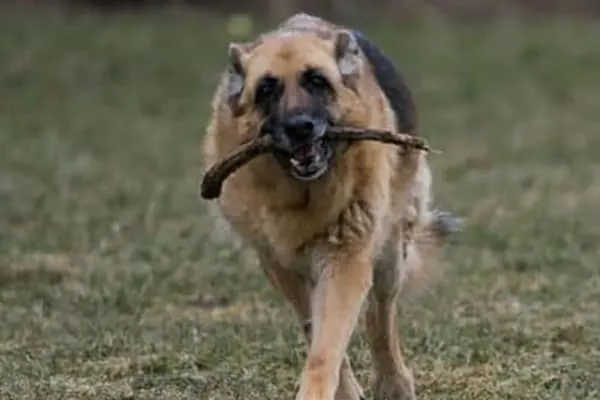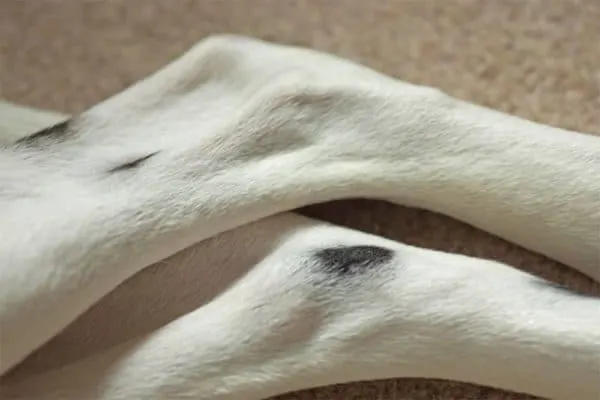A Guide To Caring For Your Aging Dog. Why Do Dogs Back Legs Give Out?
There’s nothing more upsetting than seeing your beloved pooch struggle to walk and move as their legs start to weaken and buckle with age.
But, why exactly does this happen, and what can we do as their owners to help them?
This guide will take an in-depth look at three of the main reasons why a dog’s back legs give out as they grow older, as well as some of the most effective methods for limiting the problem.

Taking A Look At The Common Causes…
1. Arthritis
Remarkably, at least 25% of dogs are diagnosed with arthritis or osteoarthritis (OA) during their lifetime.
Furthermore, up to 60% have evidence of OA on x-rays.
OA typically occurs when the cartilage in joints breaks down, which in turn leads to inflammation and pain.
This condition can affect any joint, but mainly the large joints in the front and rear legs.
Generally, larger dogs tend to develop osteoarthritis at an earlier age than smaller breeds of dog.
There are also certain breeds that are more prone to inheriting orthopedic abnormalities like hip dysplasia.
These breeds include Labrador Retrievers, Golden Retrievers, German Shepherds and Rottweilers.
If your dog suffers from advanced arthritis where one or both hips/knees are affected, they’re likely to experience trouble walking.
Therefore, this means that they’ll sometimes struggle to get up on their back legs without assistance.
Dogs with arthritis may not exhibit obvious signs of pain, but often you can recognize their discomfort by the way they stand, the way they walk, and the way they have difficulty getting up and down from a resting position.
As a result, most older dogs tend to be very stiff-gaited when they first stand up after prolonged periods lying down.

Treatment
Home remedies for canine arthritis have advanced at an impressive rate over the past couple of decades.
There are a number of treatment options available, ranging from oral medications to stem cell therapy.
Many people believe that the best supplements for dogs suffering from arthritis are UCII (undenatured collagen), fish oil, and turmeric.
The essential points to keep in mind when helping your dog with osteoarthritis are to keep their weight down, keep them moving, and immediately treat any pain they may experience.
The majority of dogs with arthritis are able to live a happy normal life with diligent monitoring and suitable medical care.
2. Degenerative Myelopathy
Degenerative Myelopathy (DM) is an inherited disease of the nervous system which has the potential to cause weak back legs in dogs as they grow older.
It has many similarities with Lou Gehrig’s disease in humans.
DM is passed on at a young age as puppies inherit a gene mutation from their parents that puts them at risk for developing the disease later in life.
Dog breeds most at risk of inheriting the disease include German Shepherds, Poodles, Pugs, Pembroke and Cardigan Welsh corgis, Collies, and Boxers.
It can also occur in mixed breed dogs.
Dog owners usually recognize the first signs of the disease when their pooch begins to occasionally drag their back feet.
This then progresses to back leg weakness and trouble walking.
Other notable indications of the disease include difficulty jumping, stumbling, weakness in back legs, “crossing-over” of rear feet, slipping, worn down toenails, and abrasions on the feet from scuffing.
A full diagnosis of DM is based on clinical symptoms, blood testing and x-rays.
In certain cases, electromyogram, spinal taps, and MRI help to verify the diagnosis.
In practice, the mainstay of diagnosing the disease is ruling out other causes of rear-limb weakness.
Life Expectancy
Unfortunately, there aren’t any proven effective treatments for Degenerative Myelopathy at this time.
You may be able to slow down the progression of the disease with nutritional supplements, plenty of exercise, a special diet, and various alternative therapies (including acupuncture and homeopathy).
The earlier you recognize some of the signs of DM, the better chance you have of stalling it.
The long-term prognosis is poor, however, with most dogs losing the ability to walk within 6-12 months of diagnosis.

3. Intervertebral Disc Disease
Intervertebral Disc Disease (IVDD) occurs when the disc cushion between the various bones of the spine breaks down and presses on spinal nerves.
In dogs, the most common sites for IVDD are the neck and the mid-to-lower back.
The thoracolumbar area is another location where the disease is prevalent within canines, and this can cause them to have weak back legs due to the pain.
In some of the most severe cases, you may see a dog’s back legs collapse or become so weak that they can no longer stand.
IVDD is prevalent in adult dogs of all ages, but older dogs are often more at risk to some of the more severe effects.
All breeds are susceptible to the disease, however breeds like German Shepherds and Dachshunds are at higher risk.
IVDD lesions can sometimes be identified by radiographs, but to know for sure, special imaging such as MRI or myelograms is required.
Special imaging is usually carried out by a veterinary specialist and requires the dog to be under anesthesia.
Treatment
The treatment for IVDD depends on the severity of the disease.
If your dog is only mildly affected with pain and little or no weakness in their legs, plenty of rest and anti-inflammatories should be enough to bring improvement for most dogs within a couple of weeks.
However, if your dog is stumbling and has significant rear limb weakness, rest and medication will take considerably longer to have an impact.
Dogs who are severely affected by the disease and can’t move their rear limbs are good candidates for surgery.
Other Common Causes
There are a number of other diseases that can cause generalized weakness in a dog’s legs.
For example, any kind of cancer or condition that causes anemia (low red blood cell count) can lead to significant weakness.
Furthermore, severe liver, kidney and heart disease can also cause a dog’s legs to weaken and collapse.




















